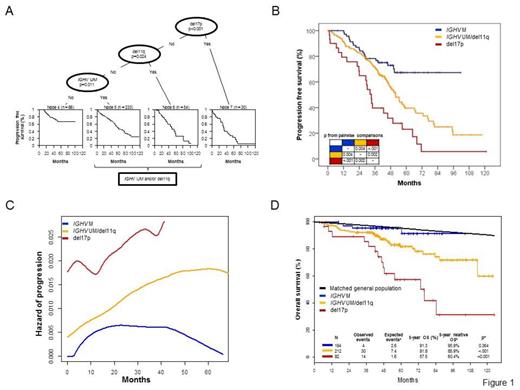Abstract
Background. Fludarabine, cyclophosphamide, and rituximab (FCR) has represented a significant advancement in the treatment of patients with chronic lymphocytic leukemia (CLL) and has the potential of inducing durable remissions of the disease. In the new scenario of targeted agents for CLL, there is an increasing interest in identifying patients who may gain the maximum benefit in terms of disease control by a single shot of FCR chemo-immunotherapy.
Purpose. Here we aimed at identifying predictors of durable remission after first line FCR treatment.
Methods. The study was based on 405 progressive and previously untreated CLL patients who consecutively received standard FCR (up to 6 cycles) as first line therapy in 19 hematologic centers between 2001 and 2010. According to an intention to treat approach, all patients who received at least one FCR cycle were registered in the study. This series was representative of a FCR treated CLL cohort with respect to baseline characteristics, including age (median: 61 years; >65 years in 33% of patients), gender (male in 68% of patients), stage (progressive Binet A in 11% of patients; Binet B in 59%; Binet C in 30%) and number of FCR courses (median: 6; <6 in 42% of patients). Most patients were evaluable for IGHV mutation status (unmutated in 192/296, 65%) and genomic aberrations at treatment requirement (17p deletion in 30/306, 9.8%; 11q deletion in 56/300, 19%; +12 in 70/298, 23%; 13q deletion in 108/301, 36%).
Results. After a median follow-up of five years, 159 patients have progressed and 72 have died, accounting for a 5-year progression free survival (PFS) according to the IWCLL criteria of 47% (median: 58 months) and for a 5-year overall survival (OS) of 81% (median: not reached). When the demographic effects of age, gender and year of treatment were compensated, the 5-year and 10-year survival of the whole CLL cohort were 85% and 68%, respectively, of those expected in the matched normal general population (p<0.001). By multivariate analysis, unmutated IGHV genes, 11q deletion and 17p deletion maintained independent association with both PFS and OS, thus providing the rationale to utilize them in the development of a model to predict remission duration after FCR. By recursive partitioning analysis, 17p deletion was the most important variable in predicting PFS after FCR, followed by 11q deletion and IGHV mutation status (Fig. 1A). Based on the application of an amalgamation algorithm, cases harboring unmutated IGHV genes and 11q deletion were grouped into a single category because they showed an identical drop of the PFS curve (Fig. 1A). By this approach, three CLL subgroups were hierarchically classified. Clinical features and treatment indication were superimposable across the three risk groups. The low risk category comprised patients harboring mutated IGHV genes but neither 11q or 17p deletion, and accounted for 26% of all cases. Most of the low risk patients (67%) remained free of progression after FCR (Fig. 1B), and their hazard of relapse dropped to zero after 5 years of follow-up. Consistently, the PFS curve of low risk patients plateaued after 5-years from FCR (Fig 1B). The life expectancy of low risk patients (91% at 5 year) was superimposable to that observed in the matched normal general population (Fig. 1D), indicating that neither the disease, nor complications of its treatment affected survival in this favorable group of CLL. Conversely, patients belonging to the intermediate risk (IGHV unmutated and/or 11q deleted) and high risk (17p deleted) categories showed a constant increase of the hazard of progression over time and almost all were projected to relapse after FCR, although at a different rate: 10% per year of follow-up in the intermediate risk group and 17% per year of follow-up in the high risk group (Fig. 1B-C). The 5-year life expectancy of intermediate and high-risk patients was significantly impaired compared to that observed in the matched general population (85% and 60%, respectively) (Fig. 1D), indicating an excess of deaths related to the disease or treatment complications in these unfavorable groups of CLL.
Conclusions. The combination of three biomarkers that are routinely tested at treatment allows to segregate a subgroup of CLL (IGHV mutated without 17p or 11q deletion) that may achieve a durable remission after first line FCR treatment and experience an expected survival similar to that of the general population.
No relevant conflicts of interest to declare.
Author notes
Asterisk with author names denotes non-ASH members.


This feature is available to Subscribers Only
Sign In or Create an Account Close Modal